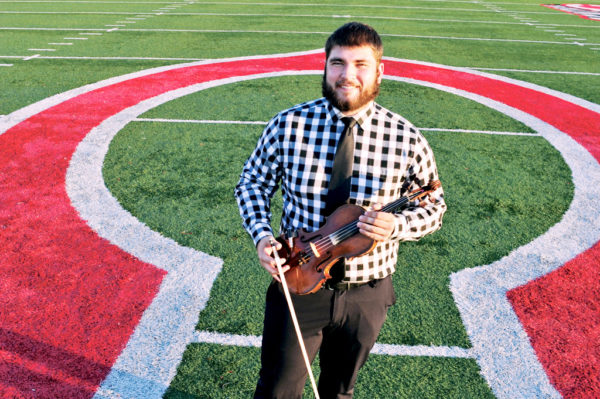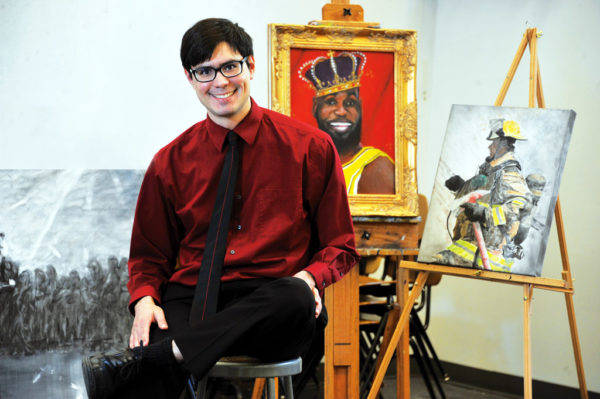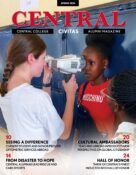
Ed Henning ’20 grew up on a farm near Hartwick, Iowa, population 79. He appreciates he can continue to play both classical violin and football at Central. “Every college you visit, they all say they’re like a family. But Central was the only one that really felt like that,” he says.
Most colleges and universities have a big problem these days: too few rural students.
“Rural students are the least likely to go to college,” National Public Radio reports. “They’re being ignored as the nation starts to ramp up degree completion.”
“Fewer than one in five rural adults aged 25 and older have college degrees, federal data show,” announces The Hechinger Report, a nonprofit that covers inequality and innovation in education.
“Rural students underrepresented in higher education,” said HigherEd Direct, the website of Higher Education Publications, Inc.
In fact, since 2017 at least 20 articles in a range of national media (including those quoted here) have all but declared rural students the most recently discovered underserved minority in higher education.
Central College is a shining exception to this national trend: The college always has enrolled a healthy proportion of rural students. During the past five years, an average of 37% of Central’s incoming freshman class came from rural areas— five times the national average for the percentage of rural students attending higher education institutions. [See “Crunching the Numbers,” below.]
APPROXIMATELY 37% OF CENTRAL STUDENTS COME FROM RURAL AREAS—ABOUT FIVE TIMES THE NATIONAL AVERAGE.
A HEALTHY BALANCE
The articles mentioned above, along with others, explain why a healthy balance of rural students in higher education is important—for all students, for higher education and for society in general.
“Rural Americans possess cultural wealth, diversity of perspective and other attributes that can enrich the enterprise of higher education,” notes the Pell Institute for the Study of Opportunity in Higher Education.
“They also tend to be more conservative politically, which may help alleviate the public perception that universities are uniformly liberal institutions,” reports tuition insurance giant Allianz in an article titled “How Colleges Can Attract Rural Students.”
“It’s not that rural students aren’t academically prepared,” says “The Rural Higher-Education Crisis,” an article in The Atlantic. “They score better on the National Assessment of Educational Progress than urban students and graduate from high school at a higher percentage than the national average, the U.S. Department of Education reports.”
“Providing greater postsecondary opportunities for rural residents isn’t simply a matter of equity or moral obligation—it’s a matter of continued national prosperity,” says Andrew Koricich, a professor of education at Appalachian State University quoted by The Hechinger Report. He points out that the U.S. economy relies heavily on rural communities and workers.
The resulting education imbalance has cultural implications, too, as the country becomes increasingly politically and economically divided along urban/rural lines.
“Given election results that turned up the volume on the concerns of rural Americans, who voted their discontent over lost jobs and economic disparities, higher education leaders are now talking about how to reach the hard-to-get-to,” reported The New York Times in its article “Colleges Discover the Rural Student.”
Put simply, students from rural areas are statistically high achievers who offer valuable political, social, cultural and experiential perspectives to class discussions, campus communities and beyond that, the national body politic. Those perspectives are woefully underrepresented at most colleges or universities, or simply are missing.

Brandon Rosas ’20 (hometown Parnell, Iowa, population 193) is another multitalented student: He’s a writer, a painter and active in Salsa dancing, among other interests. “I knew that Central had a world-renowned study abroad program, generous financial aid and strong academics and that Central went above and beyond to connect students to opportunities that suit their interests,” he says.
CRUNCHING THE NUMBERS
Central College could find no single entity that tracks the percentage of rural students currently enrolled at U.S. higher education institutions. But a few back-of-the-envelope calculations seem to give a reasonable approximation.
According to The New York Times, 29% of 18- to 24-year-olds in rural areas are enrolled in college. The U.S. Census Bureau defines 7.4% of the total U.S. population as both rural and 18-24 years old. During the past five years, an average of about 37% of Central’s incoming classes had home addresses considered rural by the U.S. Census Bureau. That means, all else being equal, Central enrolls rural students at five times the national average (37 divided by 7.4).
You might expect to see a higher percentage of rural students at an Iowa college than nationally, because overall, Iowa’s population is more rural than the national average: 36% versus 19.3%. But most of Iowa’s rural population is elderly. The percentage of Iowans who are both rural and 18-24 years old is actually less than the national average—6.4% for Iowa versus 7.4% nationally. Even if all Central students were Iowans (about 70% are), the college would be enrolling about 5.8 times the expected number of rural students (37 divided by 6.4).
WHAT TO DO?
“Higher education leaders are sitting up and taking notice of a forgotten segment of American society—the rural students, parents and community members who feel increasingly marginalized by our higher education system,” states the National Association of Colleges and Employers in an article titled “Serving Rural Students.”
The article went on to document a litany of recent attempts by various institutions to address the issue: “The University of North Carolina system released a strategic plan that focused on bolstering rural student enrollment. The University of Georgia recently announced a new initiative to support rural student success. Clemson University and Texas A&M have also expanded their rural recruitment efforts, with Texas A&M Director of Admissions Scott McDonald arguing that ‘In terms of diversity, geography is just as important as racial and ethnic.’ Liberal arts colleges such as Swarthmore College, Carleton College and Warren Wilson College have launched strategic admissions initiatives aimed at rural communities as well, and organizations such as the College Board and the College Advising Corps are seeking ways to facilitate the application process for students in more remote areas.”
And according to a Voice of America article, “A recent study of admissions directors found that 28% of private and 52% of public college admissions directors said they were interested in getting more rural students.”
THE CENTRAL SOLUTION
So how is it Central already is doing what so many higher ed institutions find elusive? Two reasons. One is Central makes recruiting a healthy balance of urban and rural students a priority. The other is the college’s welcoming community makes prospective students feel comfortable here right away, no matter where they’re from.
“We have a goal of visiting every high school in the state,” says Carol Williamson (hometown Pella, Iowa, population 10,352) Central’s vice president for enrollment and student development. “We’re nearly there. We visit a lot of them.”
That’s an unusual practice, says the Hettinger Report in an article titled “One Reason Rural Students Don’t Go to College: Colleges Don’t Go To Them.” It’s a matter of economics and convenience, the article explains, again quoting Koricich: “When we think about an urban high school, a college recruiter can hit 1,500 students at a time. To do that in a rural area, you may have to go to 10 high schools.” Central makes the effort.
“WE HAVE A GOAL OF VISITING EVERY HIGH SCHOOL IN THE STATE.”
— CAROL WILLIAMSON,
CENTRAL’S VICE PRESIDENT FOR ENROLLMENT AND STUDENT DEVELOPMENT
IT’S ABOUT RELATIONSHIPS
When prospective students visit Central’s campus, they get personalized attention— the kind to which students from smaller, rural schools are accustomed.
“We have 3,000 personalized campus visits per year from prospective students,” Williamson says. Each visit includes an individual tour and from four to eight individualized appointments per student, who are asked about their interests before they arrive. Williamson’s staff schedules appointments with professors, coaches and directors and includes visits to classes, rehearsals and practices. “We want them to feel as though they are on a personal journey that emulates what their education will be like here,” she says.
Beginning about five years ago, Central’s admission staff members even make home visits. “We’ll meet a family at a coffee shop in their hometown or around their kitchen table to explain what Central’s academic program has to offer or walk them through a financial aid package. That’s where family decisions get made,” Williamson says.
“The very first home visit we had was with Lewis Braster ’18 and his father” in Centerville, Iowa, (population 5,500) Williamson remembers. “When he graduated, his dad, Marty, stopped me to say, ‘When you came to meet us at the café, we knew this was the place for Lewis.’”
![Hillary Hamilton ’19 says, “I’m from a small town [Corydon, Iowa, population 1,585]. … Central is good at reaching the individual person rather than the crowd. Because of this, I’ve grown more confident, become more vocal and taken a more active role in my own education.”](https://civitas.central.edu/wp-content/uploads/2019/08/DSC_1094-600x399.jpg)
Hillary Hamilton ’19 says, “I’m from a small town [Corydon, Iowa, population 1,585]. … Central is good at reaching the individual person rather than the crowd. Because of this, I’ve grown more confident, become more vocal and taken a more active role in my own education.”
“CENTRAL IS GOOD AT REACHING THE INDIVIDUAL PERSON RATHER THAN THE CROWD.”
— HILLARY HAMILTON ’19
With test scores, grade point averages and tuition costs, it’s easy to feel college application comes down to numbers. “But the work we do is about people,” says Chevy Freiburger (hometown Delhi, Iowa, population 379), Central’s executive director of admission. “Everybody who applies is unique, and so are their circumstances. We treat everyone as an individual. We get to know them. It’s hard work, but it pays off— both for our applicants and for Central. We embrace the personal component of recruitment.
“In rural areas, people are invested in their communities,” Freiburger says. “At Central, they see we are invested in them in the same way.”
That personal component has been shown to resonate with rural students. “Recruiting Rural Students by Building Relationships,” an opinion piece in Inside Higher Ed, made the point “colleges that want to recruit rural students need to make personal connections,” citing a study in which students ranked such connections as having the most powerful effect on choosing an institution of the 15 influences about which they were questioned.
And it’s not just rural students who benefit from such connections. A recent analysis on student success done by The New York Times and the Urban Institute’s Center on Educational Data and Policy found that personal connections remain invaluable once a student is enrolled, no matter what the student’s pre-college background. According to “The College Dropout Crisis” a New York Times article that reported the results, “colleges with higher rates of student success…. deepen students’ connections to other people on campus, including their classmates (through extracurriculars), professors and advisors.” It quoted one college president as saying, “The bottom line is connection—feeling like somebody cares.”
“A caring, supportive community is the core of Central’s identity,” says Central President Mark Putnam. “It’s gratifying to see research that shows students learn, develop, persist and achieve more with personal attention and a sense of belonging, because our students have always told me that the relationships with faculty, staff and other mentors here are one of the best parts of their Central education.”
Impersonal jargon, on the other hand, is a turnoff to rural students, particularly those who are first-generation college-bound and may be unfamiliar with admission terminology. “College officials muddle their pitches, brochures and procedures with jargon terms—as many as 25 of them per communication—and specialized knowledge that confuse and demoralize potential students from rural areas,” writes Sonja Ardoin in her 2017 book College Aspirations And Access In Rural, Working-Class Communities: The Mixed Signals, Challenges, and New Language First-Generation Students Encounter. Central admission staff try hard to avoid this pitfall, explaining the application process—and higher education in general—in plain language.
Perhaps most of all, though, students from rural areas say it’s not just what the admission office does that attracts them to Central, although that makes a difference. And it’s not because of a special rural student initiative. It’s what Central is. The campus culture has the intimate, open, welcoming feel of a small town that makes rural students feel comfortable right away. And that’s been baked into the college since its founding in 1853.
LIKE FAMILY
Like most students, Ed Henning ’20 (hometown Hartwick, Iowa, population 79), can tell the difference between marketing and reality. In an interview with student writer Brandon Rosas ’20 (hometown Parnell, Iowa, population 193), Henning says, “Every college you visit, they all say they’re like a family. But Central was the only one that really felt like that.”

Abigail Lowry ’22 (hometown Philadelphia, population 1.6 million) says “People are so nice in Iowa—way nicer than I’m used to” in her hometown of Philadelphia, population 1.6 million. The engineering major who is also developing talents in music, poetry and art “felt welcomed when I came to visit, and everyone was so accommodating at freshmen orientation.”
That’s a sentiment echoed by nearly all Central students. But rural students such as Henning seem to particularly value it. That’s because they immediately recognize Central offers something they’ve grown up in and highly prize: A close-knit, caring community of mentors and peers that respects where they come from (wherever that may be), gets to know them personally and cares about them individually. To that Central adds the mission of helping all students find their unique path in the world—wherever it may lead.
That’s especially true if a student’s path combines multiple interests. Small high schools typically encourage students to participate in many activities rather than specialize—if nothing else because students there need to do so if a small student body is to field a team or produce a play.
Henning, for instance, played football since sixth grade and also is a classically trained violinist. Central was the only college, among several he visited, with athletics and music programs that each encouraged him both to play in the orchestra and on the football field. All the other schools’ programs told him he’d need to choose between the two activities.
That support of diverse interests is part of Central’s educational philosophy. “We encourage students to pursue multiple passions,” says Central football coach Jeff McMartin ’90 (hometown Wellsburg, Iowa, population 707). “The more opportunities students have to connect with professors, coaches, conductors— that’s what your college experience should be about. Our co-curricular programs are really good at working with each other so that students can be involved in multiple activities.”
That’s not just a service to students— it results in a better athletics program, McMartin says. “We want a well-rounded, diverse football team. There are things students from different backgrounds can teach one another. Students from small towns have a tremendous work ethic, loyalty, desire to learn and commitment to improve. They are used to being invested in a community and that really adds something to a team.”
The elements that make up Central’s caring community are reinforced by its pioneer and Dutch immigrant heritage and by its church affiliation, all of which prioritize a strong community. They’re augmented by Pella, a close-knit rural town with world-spanning cultural and business connections. It all adds up to a place that’s attractive to students no matter their hometown.
“People are so nice in Iowa—way nicer than I’m used to in Pennsylvania,” says Abigail Lowry ’22 (hometown Philadelphia, population 1.6 million) interviewed by Marin Harrington ’21 (hometown Omaha, Nebraska, population 467,000). Lowry chose to come to Central to study engineering and continue to develop her interests and talents in music, poetry and art. “I felt welcomed when I came to visit, and everyone was so accommodating at freshmen orientation. That clicked with me the most,” she says.

Marin Harrington ’21 says she came to Central to “build meaningful relationships and figure out what I wanted to do with my life.” The English major found “a new, enriching social life,” academic challenge and a focus as an editor (of the college’s Writing Anthology) and a writer (she won a first-place award in Central’s annual creative writing contest).
A RESERVE OF CONFIDENCE
Hillary Hamilton ’19 says, “I’m from a small town [Corydon, Iowa, population 1,585]. I value knowing people when I see them. The relationships between students and professors really stood out to me, and I appreciated the participation students showed in a class I sat in on as a prospective student. It’s impossible for me to walk across campus without stopping to talk to a friend or a professor. Central is good at reaching the individual person rather than the crowd. Because of this, I’ve grown more confident, become more vocal and taken a more active role in my own education.”
Hamilton deftly puts her finger on a paradoxical truth that higher ed policymakers and administrators seem to overlook: A college environment that feels familiar and safe is exactly what allows students to develop greater confidence and stretch beyond their previous comfort zones. And that benefits all students, no matter their background.
That reserve of confidence led Hamilton to explore opportunities she couldn’t previously have imagined. Even if she had, she might not have had the nerve to act on them elsewhere—especially had she been coping with the culture shock of studying at an impersonal, urban institution with a student body 20 times larger than the population of her hometown.
Hamilton started off aspiring to be a newspaper reporter. Now, after doing Central-sponsored communications research with a nonprofit, she’s aiming to be a college professor. She has been accepted to an organizational communications graduate program with a teaching assistantship where she will pursue her master’s and doctorate degrees.
Civitas profiled Rob Lindley ’95 (hometown Alta, Iowa, population 1,883) in the winter 2018 issue [“An Actor and a Gentleman”]. He tells a similar story. His high school graduating class was 45—small enough “I knew what I was good at and so did everyone else,” he says. “I would have been swallowed up at a state school. Central was a logical next rung—a place where I could learn a lot and still be a big fish.” Now, on national tour with the Broadway hit “The Phantom of the Opera,” the world is his stage.
ROOTS AND WINGS
Jonas Salk, the physician who invented the Salk polio vaccine, wrote, “Good parents give their children roots and wings. Roots to know where home is, wings to fly away and exercise what’s been taught them.”
Perhaps good colleges do, too—even if those wings choose to fly back home again. Although Central’s graduates can be found across the country and around the globe, more than 56% choose to stay in Iowa. That’s good for the state, says Jenae Jenison ’11 (hometown Pella, Iowa, population 10,352), Central’s director of external engagement and a member of the Governor of Iowa’s Empower Rural Iowa Initiative.
“The initiative calls for finding rural leaders, and Central College is identifying them as high school students, then educating and equipping them to become leaders in their communities. Many of them move back home because they know they can make a difference. I moved back to Pella from Des Moines because I could have a seat at the table to make a real change in the community,” says Jenison, who was recently named one of the Red Rock Area’s Top 10 under 40.
Henning may well do the same. He has played violin internationally, as well as with the Central College and Community Orchestra and the country band Tyler Richton and the High Bank Boys. The latter won the Iowa Country Song of the Year award in February, tours statewide and opens for national acts.
Henning, a business major, plans to take his music “as far as it can go,” then return to Hartwick and farm.
After all that rural Iowa has offered him in the way of education and opportunity, why wouldn’t he?
Know a student you think might be a good fit for Central? Let our Admission Office know and we’ll get in touch with them: 877-462-3687 or admission@central.edu.












To encourage serious, intellectual discourse on Civitas, please include your first and last name when commenting. Anonymous comments will be removed.
Ailton Do Nascimento
|
9:52 am on November 1, 2019
Ola bom dia, gostei muito da leitura e pretendo continua estudandor ok